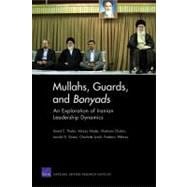
| Preface | p. iii |
| Figures | p. ix |
| Summary | p. xi |
| Acknowledgments | p. xxi |
| Abbreviations | p. xxiii |
| Introduction: Leadership Dynamics in the Islamic Republic of Iran | p. 1 |
| Assertiveness and Caution in Iranian Strategic Culture | p. 5 |
| Iran: The Conquering and Conquered Nation | p. 6 |
| Nationalism as a Tool of Policy | p. 9 |
| A New Revolutionary Paradigm | p. 13 |
| Exporting the Revolution | p. 14 |
| From Revolution to Pragmatism-and Back Again? | p. 16 |
| The End of Pragmatism? | p. 17 |
| Challenges to Iranian Power | p. 19 |
| Formal Structures of the Islamic Republic | p. 21 |
| The Supreme Leader | p. 24 |
| The President | p. 25 |
| The Majles | p. 27 |
| The Assembly of Experts | p. 28 |
| The Guardian Council | p. 29 |
| The Expediency Council | p. 30 |
| The Judiciary | p. 31 |
| The Supreme National Security Council | p. 32 |
| The Strategic Council for Foreign Relations | p. 33 |
| Iran's Security Forces | p. 33 |
| Concluding Remarks: Formal Structures | p. 35 |
| Factionalism and the Primacy of Informal Networks | p. 37 |
| The System: A Web of Personalities, Networks, and Institutions | p. 39 |
| A Men's Club of Key Personalities | p. 43 |
| The Supreme Leader: A Dominant Personality, but His Power Is Not Limitless | p. 44 |
| Other Personalities: Prominence Is Tied to Proximity to the Supreme Leader | p. 48 |
| A New Generation | p. 51 |
| Informal Networks and Patronage Systems of the Khodi | p. 52 |
| The 1980s: Era of the Clerics | p. 54 |
| The 1990s: Era of the Bonyads | p. 56 |
| The 2000s: Era of the Revolutionary Guards | p. 58 |
| Formal Institutional Structure as a Playing Field for Informal Networks | p. 64 |
| Factions: Supernetworks of Individuals, Relationships, and Power Centers | p. 67 |
| Concluding Remarks: Factionalism and Informal Networks | p. 73 |
| The Nexus of Domestic Politics and Policymaking in Iran | p. 75 |
| Foreign Policy as a Backdrop for Domestic Politics | p. 76 |
| Factional Policy Differences | p. 78 |
| Iranian Policy in the Middle East: Factional Determinants and Geopolitical Context | p. 82 |
| Factional Views of Middle East Policy | p. 84 |
| Summary: Leadership Dynamics and Iranian Middle East Policy | p. 91 |
| The Nuclear Case: Factionalism, Personality, and Policymaking | p. 92 |
| The Reformist Approach: Building Confidence Abroad, Losing Ground at Home | p. 93 |
| The Principlist Approach: Maintaining "Steadfastness" | p. 95 |
| Factionalism and Personal Rivalry Deepen Under Ahmadinejad | p. 97 |
| Khamenei's Factional Preferences Regarding the Nuclear Issue | p. 102 |
| Summary: Leadership Dynamics and Iranian Nuclear Policy | p. 106 |
| The Emergence of the Economy as a Factional Battleground | p. 107 |
| Summary: Leadership Dynamics and Iranian Economic Policy | p. 112 |
| Concluding Remarks: Domestic Politics and Policymaking | p. 113 |
| Conclusion: Power and Politics in the Islamic Republic | p. 115 |
| Key Observations on How the Iranian Political System Works | p. 115 |
| The Informal Trumps the Formal and Is the System | p. 116 |
| The Supreme Leader Retains the Most Power, but He Is Not Omnipotent | p. 116 |
| Factional Competition Drives Political Discourse and Policymaking | p. 118 |
| Iran's Domestic Power Politics Are Highly Dynamic and Periodic | p. 119 |
| Emerging Trends to Watch in Iran | p. 120 |
| The Revolutionary Guards: Will They Rise or Fall? | p. 120 |
| The Old Guard: Vulnerable to Challenge? | p. 122 |
| The Next Supreme Leader: Who or What Will Succeed Khamenei? | p. 123 |
| Concluding Thoughts for U.S. Policymakers | p. 124 |
| Bibliography | p. 127 |
| Table of Contents provided by Ingram. All Rights Reserved. |
The New copy of this book will include any supplemental materials advertised. Please check the title of the book to determine if it should include any access cards, study guides, lab manuals, CDs, etc.
The Used, Rental and eBook copies of this book are not guaranteed to include any supplemental materials. Typically, only the book itself is included. This is true even if the title states it includes any access cards, study guides, lab manuals, CDs, etc.